Why Are My Backyard Birds Fighting?
Updated: Jan. 11, 2024
Are your backyard birds squabbling over seed? Learn why birds face off at your feeders—and how to promote peace in your feathered friends.
Envision an episode of your favorite workplace sitcom centering around a protagonist’s troubles, triumphs and, at times, failures. When it comes to TV, we love watching drama unfold. The next time your heart races at the sight of birds fighting, remember this comparison. The behavior is normal and showcases fascinating parallels between how birds and humans handle conflict.
Do fighting hummingbirds ever hurt each other?
Mindset Matters
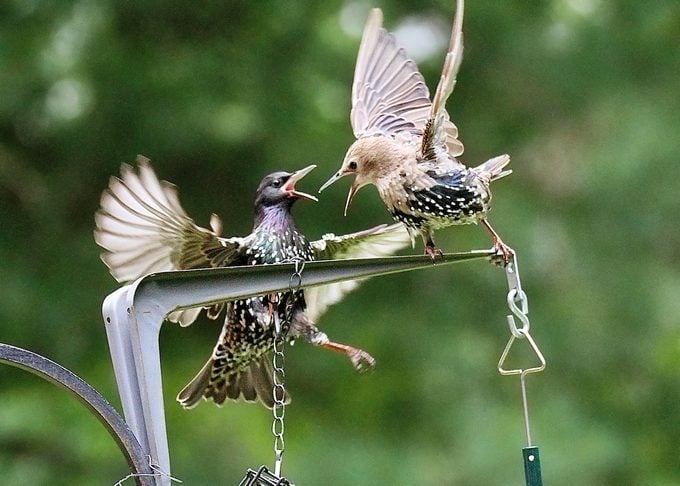
The emotional upset we experience when witnessing our feathered friends fighting is called anthropomorphizing. That means we’re attributing common human characteristics or behaviors to them.
Humans’ social behavior is complex and nuanced. We present ourselves differently in various situations to achieve a conscious or subconscious goal.
Birds are bright, but ultimately they are fighting to survive. And while many of us dislike strife, birds do too! Both humans and birds go out of their way to avoid ruffling feathers.
Learn how to (safely) deter nuisance birds from perching.
Research on Birds Fighting
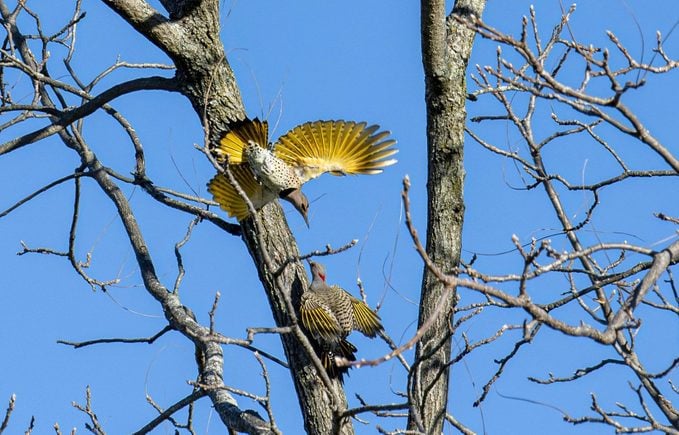
When it comes to backyard battles, there are some consistent winners and losers. Eliot T. Miller, a Schmidt Science postdoctoral fellow based at The Cornell Lab of Ornithology, has studied birds’ interactions extensively based on behavioral research from Project FeederWatch data. “The idea was to ultimately collect a big enough dataset that we could address some big-scale, macroecological questions,” Eliot says.
Through the analysis of more than 250,000 individual bird interactions, with flocks mostly excluded, what was once cloudy about the bird-world pecking order became clear.
“Findings show that if ‘Species A’ beats ‘Species B,’ and ‘Species B’ beats ‘Species C,’ then ‘Species A’ beats ‘Species C,’ ” Eliot says. “It’s a broadly linear dominance hierarchy. This allows us to predict how species act.”
One example, according to Eliot: “You might never see ‘Species A’ and ‘Species C’ interact because they live in separate regions, but you can closely infer their behavior.”
Learn how to get rid of blackbirds and grackles at feeders.
Dominant Birds Emerge
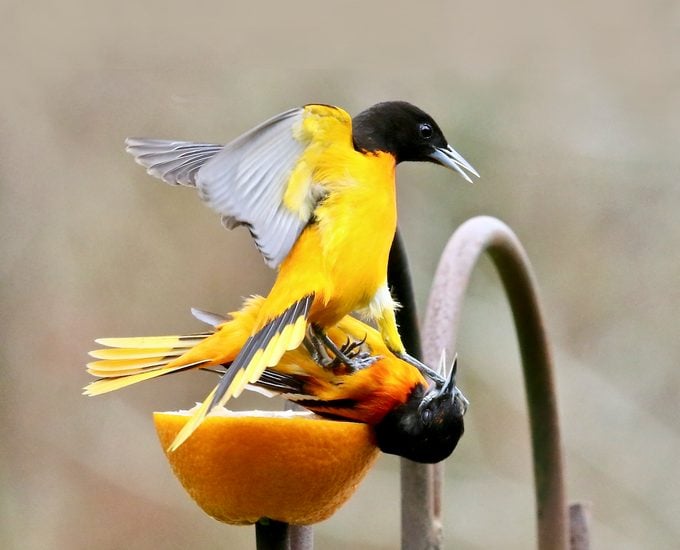
When it comes to winning bird feuds, scientists determined that beaks and build are the best predictors. Common aggressors include blue jays, grackles, starlings and woodpeckers, who “get to be pretty big and pugnacious and have big bills, so they tend to win,” Eliot says. While others, such as red-winged blackbirds, aren’t the largest in size, their flock status gives them the power to win the feeder wars.
Size doesn’t always matter, however. “The biggest bullies are the hummingbirds, in my opinion,” says Bob Bryerton, program coordinator at the Plum Creek Nature Center and Monee Reservoir in Will County, Illinois. “They are super territorial.”
For blue jays, their behavior isn’t about territory. “In my experience, they are kind of shy and not particularly aggressive,” Bob says. “Because they are large, other birds move away from them, and they are loud and boisterous.”
Submissive Bird Species
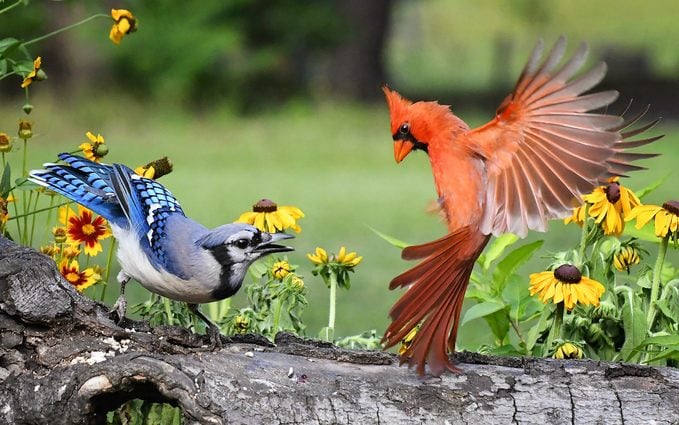
Some of the more passive birds include thrushes, thrashers and robins. Also low on the hierarchal list are rose-breasted grosbeak, painted bunting, longspur and snow bunting, which “tend to be really low, pound for pound,” on the hierarchy, Eliot says. “Doves are way lower than expected,” he says. Surprisingly, northern cardinals are not high in the ranking despite their size.
“With birds, things aren’t always fair,” Bob says. “People want birds to share, and birds are not good at sharing. They are going to take advantage of the resource they have and use it.” Whether in our backyards or in the wild, conflict happens—but there’s simply more room to spread out in the wild. “It’s uncontested that more aggression is happening around feeders than in the woods,” Bob says, but it does occur in natural areas too.
Meet the friendliest birds in America.
Stop Birds Fighting: Create a Sense of Harmony
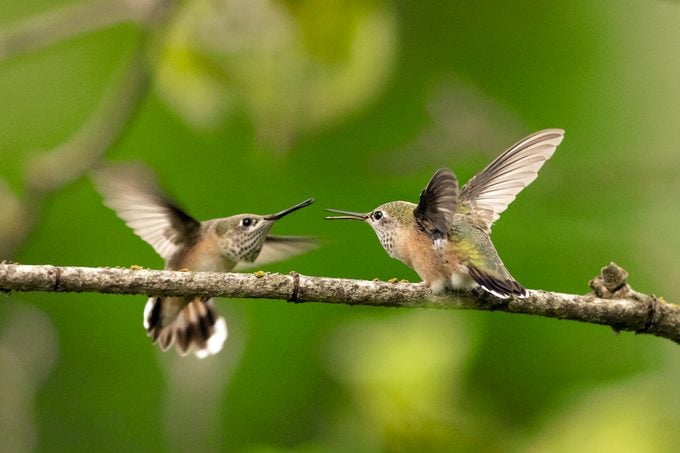
Fighting isn’t fun for anyone involved. “Even if you are going to win, it’s a costly, energy-consuming behavior,” Eliot says. To successfully support all birds, consider your feeder placement as if you’re planning a perfect puzzle. Have multiple types of feeders and seed options spread throughout the backyard to keep the birds under your wing.
For example, woodpeckers bend upside down to access ground-facing suet feeders, but competitors may not be willing to go belly-up. That tip alone may help rid you of blue jays or starlings if they’re overwhelming other feeder birds.
You can also connect with a wild bird feeding store. And talk with area greenhouses about native plants for a cost-effective approach to a balanced backyard.
Why Trust Us
For nearly 30 years, Birds & Blooms, a Trusted Media Brand, has been inspiring readers to have a lifelong love of birding, gardening and nature. We are the #1 bird and garden magazine in North America and a trusted online resource for over 15 million outdoor enthusiasts annually. Our library of thousands of informative articles and how-tos has been written by trusted journalists and fact-checked by bird and garden experts for accuracy. In addition to our staff of experienced gardeners and bird-watchers, we hire individuals who have years of education and hands-on experience with birding, bird feeding, gardening, butterflies, bugs and more. Learn more about Birds & Blooms, our field editor program, and our submission guidelines.
Sources
- Interview, Eliot T. Miller, Schmidt Science postdoctoral fellow
- Interview, Bob Bryerton, program coordinator, Plum Creek Nature Center, Forest Preserve District of Will County
- Forest Preserve of Will County: Look Out For Backyard Bullies
- The Cornell Lab’s Project FeederWatch: Who Is the Toughest Bird?
- Royal Society Publishing (Eliot T. Miller): The Effect of Sociality of Competitive Interactions Among Birds
- Oxford Academic (Eliot T. Miller): Fighting Over Food Unites the Birds of North America in a Continental Dominance Hierarchy
- Oxford Academic (Eliot T. Miller): Why Do Crows Attack Ravens? The Roles of Predation Threat, Resource
Competition and Social Behavior - Springer Link (Eliot T. Miller): Both Morphological and Behavioral Traits Predict Interspecific Social Dominance in Birds
- The Journal of Avian Biology (Eliot T. Miller): Congeneric Predators Fill Discrete Niches Created by the Relative Abundances of Their Prey Species
- Science Direct (Eliot T. Miller): The Hairy-Downy Game Revisited: An Empirical Test of Interspecific Social Dominance Mimicry Hypothesis
- The Cornell Lab’s of Ornithology’s All About Birds (Alison Haigh): When 136 Birds Species Show Up At A Feeder, Which One Wins?
- The Atlantic (Noah Charney): Cracking the Sitcom Code
- Better Up (Allaya Cooks-Campell): What Is Code Switching And How Does It Impact Teams?




















